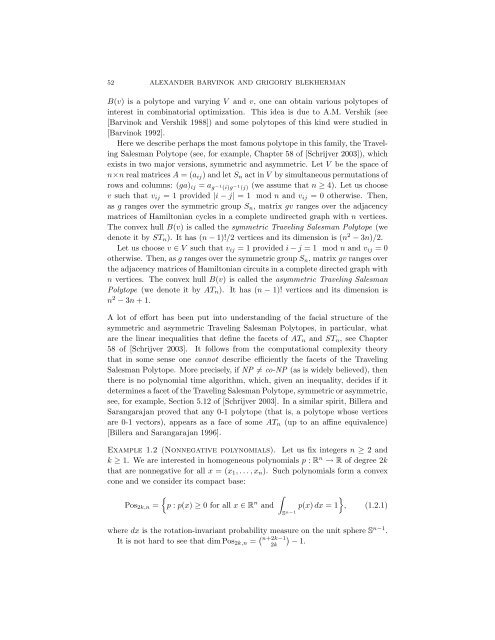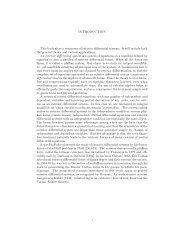You also want an ePaper? Increase the reach of your titles
YUMPU automatically turns print PDFs into web optimized ePapers that Google loves.
52 ALEXANDER BARVINOK AND GRIGORIY BLEKHERMAN<br />
B(v) is a polytope and varying V and v, one can obtain various polytopes <strong>of</strong><br />
interest in combinatorial optimization. This idea is due to A.M. Vershik (see<br />
[Barvinok and Vershik 1988]) and some polytopes <strong>of</strong> this kind were studied in<br />
[Barvinok 1992].<br />
Here we describe perhaps the most famous polytope in this family, the Traveling<br />
Salesman Polytope (see, for example, Chapter 58 <strong>of</strong> [Schrijver 2003]), which<br />
exists in two major versions, symmetric and asymmetric. Let V be the space <strong>of</strong><br />
n×n real matrices A = (aij) and let Sn act in V by simultaneous permutations <strong>of</strong><br />
rows and columns: (ga)ij = a g −1 (i)g −1 (j) (we assume that n ≥ 4). Let us choose<br />
v such that vij = 1 provided |i − j| = 1 mod n and vij = 0 otherwise. Then,<br />
as g ranges over the symmetric group Sn, matrix gv ranges over the adjacency<br />
matrices <strong>of</strong> Hamiltonian cycles in a complete undirected graph with n vertices.<br />
The convex hull B(v) is called the symmetric Traveling Salesman Polytope (we<br />
denote it by STn). It has (n − 1)!/2 vertices and its dimension is (n 2 − 3n)/2.<br />
Let us choose v ∈ V such that vij = 1 provided i − j = 1 mod n and vij = 0<br />
otherwise. Then, as g ranges over the symmetric group Sn, matrix gv ranges over<br />
the adjacency matrices <strong>of</strong> Hamiltonian circuits in a complete directed graph with<br />
n vertices. The convex hull B(v) is called the asymmetric Traveling Salesman<br />
Polytope (we denote it by ATn). It has (n − 1)! vertices and its dimension is<br />
n 2 − 3n + 1.<br />
A lot <strong>of</strong> effort has been put into understanding <strong>of</strong> the facial structure <strong>of</strong> the<br />
symmetric and asymmetric Traveling Salesman Polytopes, in particular, what<br />
are the linear inequalities that define the facets <strong>of</strong> ATn and STn, see Chapter<br />
58 <strong>of</strong> [Schrijver 2003]. It follows from the computational complexity theory<br />
that in some sense one cannot describe efficiently the facets <strong>of</strong> the Traveling<br />
Salesman Polytope. More precisely, if NP �= co-NP (as is widely believed), then<br />
there is no polynomial time algorithm, which, given an inequality, decides if it<br />
determines a facet <strong>of</strong> the Traveling Salesman Polytope, symmetric or asymmetric,<br />
see, for example, Section 5.12 <strong>of</strong> [Schrijver 2003]. In a similar spirit, Billera and<br />
Sarangarajan proved that any 0-1 polytope (that is, a polytope whose vertices<br />
are 0-1 vectors), appears as a face <strong>of</strong> some ATn (up to an affine equivalence)<br />
[Billera and Sarangarajan 1996].<br />
Example 1.2 (Nonnegative polynomials). Let us fix integers n ≥ 2 and<br />
k ≥ 1. We are interested in homogeneous polynomials p : R n → R <strong>of</strong> degree 2k<br />
that are nonnegative for all x = (x1,...,xn). Such polynomials form a convex<br />
cone and we consider its compact base:<br />
Pos2k,n =<br />
�<br />
p : p(x) ≥ 0 for all x ∈ R n and<br />
�<br />
S n−1<br />
p(x)dx = 1<br />
�<br />
, (1.2.1)<br />
where dx is the rotation-invariant probability measure on the unit sphere Sn−1 �<br />
.<br />
− 1.<br />
It is not hard to see that dimPos2k,n = � n+2k−1<br />
2k




